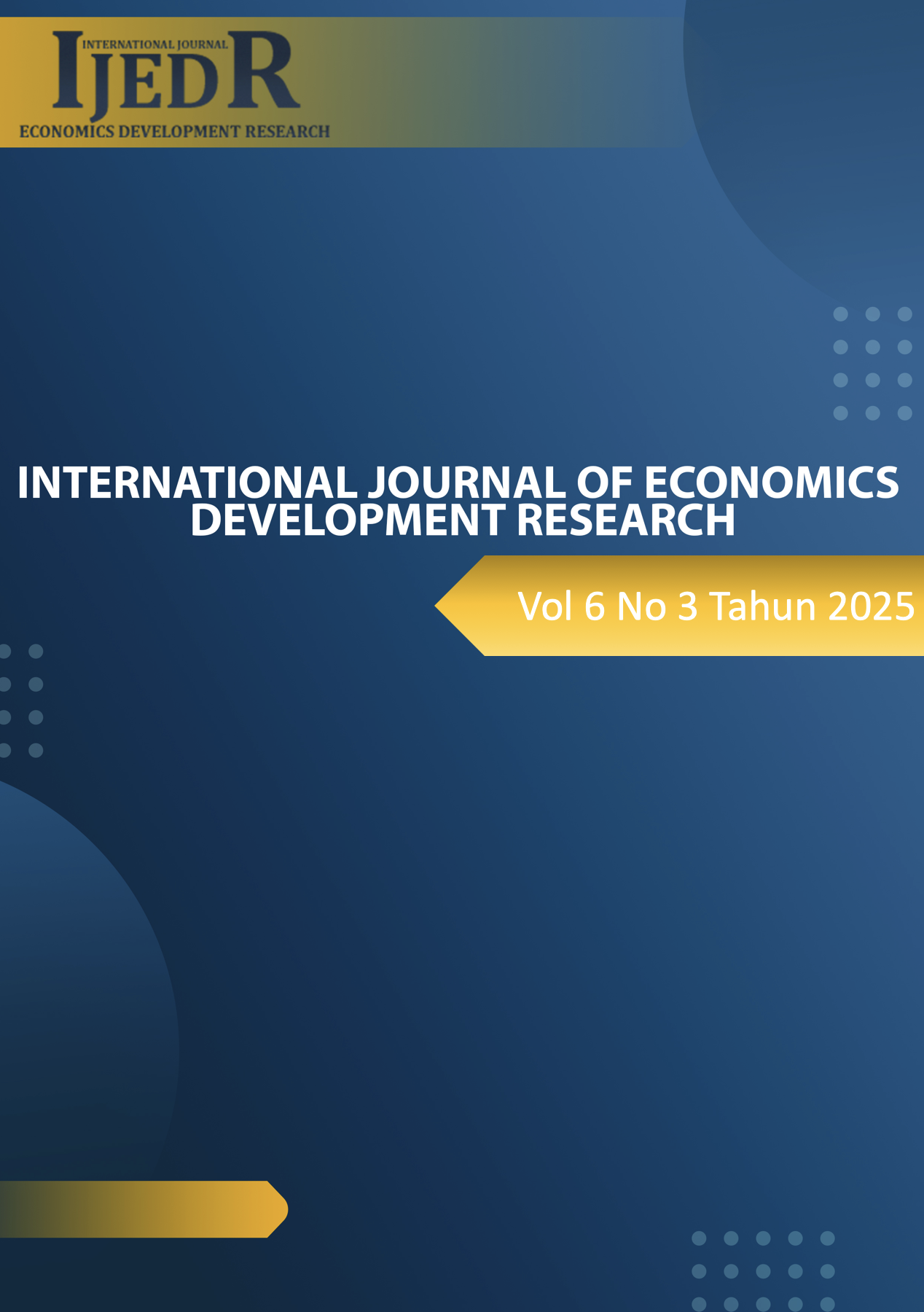The Influence of Village Fund Allocation on Economic Growth in South Sumatra Province 2016–2023
DOI:
https://doi.org/10.37385/ijedr.v6i3.7738Keywords:
Village Fund Allocation, Economic Growth, Regional Development, South Sumatra, GRDPAbstract
This study investigates the influence of Village Fund Allocation (ADD) on economic growth in 13 regencies of South Sumatra Province from 2016 to 2023. Using panel data regression analysis with the Common Effect Model (CEM) as the best estimated model, the research also examines the impact of other variables including the Human Development Index (HDI), Regional Budget (APBD), Construction Cost Index (IKK), number of community health centers (HEALTH), and labor force (EMP). The empirical findings reveal that ADD and HDI have a statistically significant influence on regional economic growth, with ADD demonstrating a negative effect, while HDI exerts a positive influence. In contrast, APBD, IKK, HEALTH, and EMP show no significant relationship with economic growth. The results suggest that while human capital development plays a critical role in promoting sustainable economic progress, the effectiveness of fiscal policies such as ADD and APBD depends heavily on governance quality and institutional capacity. The study highlights the need for institutional reform, transparent fund management, and a development strategy tailored to local potential to ensure inclusive and productive regional economic growth.
References
Airy Putri, R., Zamzami, & Rahmadi, S. (2021). Pengaruh Belanja Daerah Terhadap Pertumbuhan Ekonomi dan Kemiskinan. E-Jurnal Perspektif Ekonomi Dan Pembangunan Daerah, 10(2), 107–122.
Akmalia, T., Arifah, N., & Lutfyansyah, Y. S. (2024). Analisis Teori Ekonomi Kekembagaan atau Institusional dan Relevansinya Pada Perekonomian Di Indonesia. Jurnal Ekonomi & Bisnis, 9(2).
Alie, A. (2023). Pengaruh Penyediaan Infrastruktur Daerah Terhadap Pertumbuhan Ekonomi di Kabupaten Gunung Mas. Jurusan Ekonomi Pembangunan Fakultas Ekonomi, Universitas Palangka Raya, 05(1), vol(05)28-43.
Allya, S. B. K., Diajeng, A. C. S., & Fatkurohman, N. R. (2024). Modernisasi Melalui Pembangunan Menuju Kesejahteraan Masyarakat Indonesia. Jurnal Ilmu Sosial Dan Humaniora, 2(3), 65–75. https://doi.org/10.62383/wissen.v2i3.172
Andri Prasetyo, T., & Dinarjito, A. (2021). Analisis Pengaruh Dana Desa Dan Indeks Pembangunan Manusia PER Kabupaten Terhadap Produk Domestik Regional Bruto Di Indonesia Dengan Pembangian Wilayah Sebagai Variabel Kontrol. Jurnal Perbendaharaan, Keuangan Negara Dan Kebijakan Publik, vol(6)375-391.
Aschauer, D. A. (1989). Is Public Expenditure Productive? Journal of Monetary Economics, 23, 177–200.
Aspiansyah, A., & Damayanti, A. (2019). Model Pertumbuhan Ekonomi Indonesia: Peranan Ketergantungan Spasial. Jurnal Ekonomi Dan Pembangunan Indonesia, 19(1), 62–83. https://doi.org/10.21002/jepi.2019.04
Blackwell, W. (2015). The Globalization and Development Reader Perspectives on Development and Global Change.
Dira, A. F., Prambudi Utomo, K., Yani Pramularso, E., & Syarief, F. (2023). Pengaruh Investasi dan IPM terhadap Pertumbuhan Ekonomi Hijau di Provinsi Kalimantan Timur. Jurnal Ekombis Review, 11(2), 1437–1446. https://doi.org/10.37676/ekombis.v11i12
Dwi Astuti, E., & Setya Wijaya, R. (2024). Pengaruh Indikator Indeks Pembangunan Manusia dan Jumlah Penduduk Terhadap Pertumbuhan Ekonomi di Kabupaten Sampang. Jambura Economic Education Journal, 6(2), 397–418.
E Bloom, D., & Canning, D. (2000). The Health and Wealth of Nations. www.sciencemag.org
Elhorst, J. P. (2024). Raising the bar in spatial economic analysis: two laws of spatial economic modelling. Spatial Economic Analysis, 19(2), 115–132. https://doi.org/10.1080/17421772.2024.2334845
Elsyan Rienette, M., Ester lidya Mandowen, J., & Patty, R. (2020). Analisis Pengaruh Penanaman Modal Asing, Tenaga Kerja dan Indeks Kemahalan Konstruksi Terhadap Pertumbuhan Ekonomi di Lima Wilayah Adat Provinsi PAPUA Periode 2012-2016. Jurnal Kajian Ekonomi Dan Studi Pembangunan, 1–19.
Fischer, M. M. (2011). A spatial Mankiw-Romer-Weil model: Theory and evidence. Annals of Regional Science, 47(2), 419–436. https://doi.org/10.1007/s00168-010-0384-6
Gobel, Y. P. (2022). Implementasi Pemanfaatan Alokasi DanaDesa (ADD) Terhadap Kinerja Perekonomian Daerah Di INDONESIA. Jurnal Akuntansi, Keuangan Dan Audit Syariah, 1(1), vol(1)61-70. https://e-journal.iaingorontalo.ac.id/index.php/akasyah
Hamdi, B., & Widiastuti, T. (2021). An Islamic Economic Perspective on Public Finance Revenue in Indonesia. AFEBI Islamic Finance and Economic.
Handayani, A. P., & Badrudin, R. (2019). Evaluation of Village Fund Allocation on Indonesia. Journal of Accounting and Investment, 20(3), 284–295. https://doi.org/10.18196/jai.2003129
Hanif, I., Wallace, S., & Gago-de-Santos, P. (2020). Economic Growth by Means of Fiscal Decentralization: An Empirical Study for Federal Developing Countries. Journal Sage Open, 10(4). https://doi.org/10.1177/2158244020968088
Harris, D. J. (2007). The Classical Theory of Economic Growth. Forthcoming in The New Palgrave Dictionary of Economics, 2.
Hasanah Imnur, R., Harahap, I., & Inayah, N. (2023). Pengaruh Jumlah UMKM dan Jumlah Tenaga Kerja Terhadap Pertumbuhan Ekonomi Masyarakat SUMATERA UTARA. Economic and Business Management International Journal Mei 2023 |, 5(2), 2715–3681. https://doi.org/10.556442
imammudin, Y., Galuh Satriatama, K., & Anjaska, R. (2023). Pemenuhan Investasi Daerah dan Tingkat Pendidikan Terhadap Pertumbuhan Ekonomi Kota Bandar Lampung. Jurnal Edukasi Ekonomi, 8(1), 51–60. http://jurnal.untan.ac.id
Lestari WIDARNI, E., & Bawono, S. (2021). Human Capital, Technology, and Economic Growth: A Case Study of Indonesia. Journal of Asian Finance, 8(5), 29–0035. https://doi.org/10.13106/jafeb.2021.vol8.no5.0029
Rama Bhaskara Praja. (2023). Analisis Pengaruh Pembangunan Infrastruktur Jalan, Sekolah, Rumah Sakit, Puskesmas, Dan Penyediaan Air Bersih Terhadap PDRB Di Seluruh Provinsi Di Indonesia Tahun 2016 - 2018. Jurnal Bayesian: Jurnal Ilmiah Statistika Dan Ekonometrika, 3, 200–209. https://doi.org/doi.org/10.46306/bay.v3i2
Rimawan, M., & Aryani, F. (2019). Pengaruh Alokasi Dana Desa Terhadap Pertumbuhan Ekonomi, Indeks Pembangunan Manusia Serta Kemiskinan Di Kabupaten BIMA. Jurnal Ilmiah Akuntansi Dan Humanika, 9(3), 287–295.
Ritonga, A., Handra, H., & Andrianus, F. (2021). Pengaruh Dana Desa Terhadap Pertumbuhan Ekonomi Dan Kemiskinan Di Sumatera Barat. Jurnal Pembangunan Wilayah Dan Perencanaan Partisipatif, 16(2), 277–290. https://doi.org/10.20961/region.v16i2.32968
Sabrina, C. N., & Suhartono, E. (2023). Jumlah Tenaga Kerja dan Jumlah Pengangguran Terhadap Pertumbuhan Ekonomi Provinsi Jawa Timur Tahun 2012-2021. Sosio E-Kons, 15(1), 1. https://doi.org/10.30998/sosioekons.v15i1.15051
Saputra, B. E. (2024). Pengaruh Kemahalan Konstruksi, Keparahan Kemiskinan, dan Pengeluaran per Kapita Terhadap PDRB Konstruksi Di Wilayah eks Karesidenan SURAKARTA. Jurnal Litbang Provinsi Jawa Tengah, 21(2), 193–204. https://doi.org/10.36762/jurnaljateng.v21i2.1067
Todaro, M. P. ., & Smith, S. C. . (2020). Economic development. Pearson.
Wau, M., Wati, M. S. L., Jhon, M. S., & Fau, F. (2022, January). Teori Pertumbuhan Ekonomi (Kajian Konseptual dan Empirik).
Wijayanto, B. (2019). Teori Pertumbuhan Endogenous. https://doi.org/http://dx.doi.org/10.2139/ssrn.3317961
Yusrizal, Nurjannah, & Salman. (2023). Analisis Jumlah UMKM Dan Jumlah Tenaga Kerja Terhadap Pertumbuhan Ekonomi Di Kota Langsa. Journal of Creative Student Research (JCS, 1, 36–45.
Zain, M. F., & Deviani, D. (2024). Pengaruh Alokasi Dana Desa terhadap Pertumbuhan Ekonomi: Studi Empiris pada Daerah Tertinggal di Indonesia pada Tahun 2019-2020. Jurnal Eksplorasi Akuntansi, 6(2), 517–526. https://doi.org/10.24036/jea.v6i2.1052





